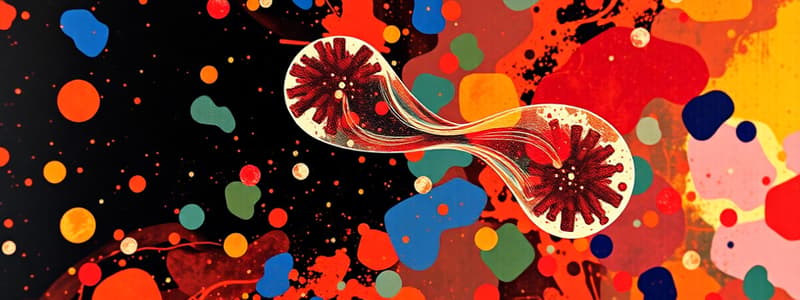Podcast
Questions and Answers
Which of the following processes is NOT directly mediated by the IgG antibody?
Which of the following processes is NOT directly mediated by the IgG antibody?
- Activation of the classical pathway of complement.
- Agglutination in mucosal linings to protect against infection. (correct)
- Antibody-dependent cell-mediated cytotoxicity (ADCC).
- Neutralization of toxins like tetanus toxin.
A pregnant woman is exposed to a novel virus during her first trimester. Which immunoglobulin is LEAST likely to provide passive immunity to her developing fetus?
A pregnant woman is exposed to a novel virus during her first trimester. Which immunoglobulin is LEAST likely to provide passive immunity to her developing fetus?
- IgG4
- IgG1
- IgM (correct)
- IgG3
Which characteristic is MOST attributed to the pentameric structure of IgM?
Which characteristic is MOST attributed to the pentameric structure of IgM?
- Prolonged half-life in circulation due to its size.
- Increased effectiveness in activating complement. (correct)
- Superior capability to neutralize toxins compared to other isotypes.
- Enhanced ability to cross cellular barriers.
A patient presents with a suspected parasitic infection. Elevated levels of which immunoglobulin would MOST strongly support this diagnosis?
A patient presents with a suspected parasitic infection. Elevated levels of which immunoglobulin would MOST strongly support this diagnosis?
Why is IgA's inability to fix or activate complement SIGNIFICANT in mucosal immunity?
Why is IgA's inability to fix or activate complement SIGNIFICANT in mucosal immunity?
A researcher is studying B cell development and identifies a population of B cells that co-express IgM and IgD on their surface. What does this finding MOST likely indicate about these B cells?
A researcher is studying B cell development and identifies a population of B cells that co-express IgM and IgD on their surface. What does this finding MOST likely indicate about these B cells?
A patient has a genetic defect that impairs the function of the J chain. Which immunoglobulin's function would be MOST affected by this defect?
A patient has a genetic defect that impairs the function of the J chain. Which immunoglobulin's function would be MOST affected by this defect?
What is the MOST likely outcome of administering an anti-IgE antibody to a patient with severe allergies?
What is the MOST likely outcome of administering an anti-IgE antibody to a patient with severe allergies?
Which of the following BEST describes the mechanism by which IgG antibodies neutralize viruses?
Which of the following BEST describes the mechanism by which IgG antibodies neutralize viruses?
A patient is diagnosed with a deficiency in IgG4. Which of the following conditions is MOST likely associated with this deficiency?
A patient is diagnosed with a deficiency in IgG4. Which of the following conditions is MOST likely associated with this deficiency?
Flashcards
IgG Function
IgG Function
Predominant in blood, lymph, CSF, and peritoneal fluid; opsonizes, agglutinates, crosses placenta, mediates cytotoxicity, neutralizes toxins/viruses, and activates complement.
IgG Subclasses
IgG Subclasses
Promotes inflammation and phagocytosis of bacteria, also causes B-cells to produce immunoglobulins.
IgM Function
IgM Function
First antibody produced upon exposure; activates complement and agglutination effectively, but has poor toxin and viral neutralization.
IgD Function
IgD Function
Signup and view all the flashcards
IgE Function
IgE Function
Signup and view all the flashcards
IgA Function
IgA Function
Signup and view all the flashcards
IgG Characteristics
IgG Characteristics
Signup and view all the flashcards
IgM Characteristics
IgM Characteristics
Signup and view all the flashcards
IgE Characteristics
IgE Characteristics
Signup and view all the flashcards
IgA Characteristics
IgA Characteristics
Signup and view all the flashcards
Study Notes
- Immunoglobulin isotopes are categorized into five classes: IgM, IgD, IgG, IgE, and IgA, distinguished by the constant region of the antibody.
IgG
- IgG has a molecular weight of 150 kDa.
- It predominates in blood, lymph, cerebrospinal fluid, and peritoneal fluid.
- Constitutes 15% of total serum proteins.
- Circulates as a monomer.
- Has a half-life of approximately 23 days.
- Has subclasses IgG1, IgG2, IgG3, and IgG4, differing in heavy chain constant region length.
- Deficiencies in IgG subclasses indicate specific conditions; IgG4 deficiency suggests allergy.
- The IgG2 subclass further divides into IgG2a (inflammation promotion) and IgG2b (antibody production promotion).
- IgG performs opsonization, coating pathogens for easy destruction.
- The Fab portion binds to the antigen of a bacteria.
- The Fc portion of IgG is detectable by phagocytes, such as macrophages, facilitating engulfment of the bacteria.
- IgG performs agglutination, forming precipitates to facilitate phagocytosis.
- IgG binds to bacteria, forming clusters to facilitate detection and destruction.
- IgG is the only immunoglobulin to cross the placenta (excluding IgG2).
- IgG receptors on the placenta facilitate the transfer of immunity from mother to fetus, starting around 3-4 months of pregnancy.
- Performs antibody-dependent cell-mediated cytotoxicity, where the Fab region binds to abnormal cells like tumor cells, attracting natural killer cells via the Fc region to release cytotoxins and kill the tumor.
- It neutralizes toxins like tetanus, botulism, and snake/scorpion venom by attaching to and inactivating the toxins' active sites.
- IgG neutralizes viruses by binding to viral epitopes (antigens), preventing viral absorption and release.
- IgG activates the classical pathway of complement, stimulating an immune response.
IgM
- IgM has a molecular weight of 900 kDa.
- Forms a pentameric structure in the bloodstream when secreted, held together by disulfide bonds called the J chain.
- The first antibody produced and expressed upon exposure to an infectious agent.
- Possesses a short half-life of about 5 days.
- The pentameric structure makes it effective at activating complement and agglutination.
- The classical pathway of complement is activated by IgM.
- IgM has poor toxin and viral neutralization capabilities.
- Does not cross the placenta; IgG is the only antibody to do so.
- First immunoglobulin made by the fetus at five months.
- Exhibits isohemagglutinin activity.
IgD
- Molecular weight of 180 kDa.
- Not a secreted immunoglobulin; it is membrane-bound.
- Expressed on the membranes of B cells and plasma cells.
- Found in low concentrations in the serum (bloodstream).
- Can be co-expressed with IgM on B cells and is a marker for B-cell maturity.
- B cells expressing both IgM and IgD are not yet plasma cells.
- Full function of IgD is still unknown.
IgE
- Molecular weight of about 200 kDa.
- Secreted as a monomer.
- Has a half-life of about 2 days, which can increase when bound to mast cells or basophils.
- Does not agglutinate or fix complement.
- Binds to mast cells and basophils, increasing its half-life to about two weeks.
- Mast cells have Fc epsilon receptors for IgE antibodies.
- When IgE bound to mast cells binds to antigens of pathogens, it triggers the mast cell to release granules containing histamine.
- Histamine is an inflammatory mediator implicated in hypersensitivity reactions.
- Mediates allergic reactions via histamine release from mast cells.
- Has some function in protection against parasites, such as worms.
IgA
- Has a molecular weight of about 165 kDa.
- Can be secreted as a monomer or dimer, especially in the mucosal system, found in the respiratory tract, genital tract, and gut.
- In dimeric form, IgA is held together by a J chain.
- Has a half-life of about 5.5 days.
- It Serves as the main immunoglobulin in mucus, providing primary defense against mucosal infections.
- There are two subclasses of IgA: IgA1 (93%) and IgA2 (7%).
- Defends against mucosal infections such as HIV, Helicobacter pylori, and Streptococcus pneumoniae.
- Does not fix or activate complement to avoid inflammatory responses in the mucosal tract.
- Exhibits agglutination and antiviral capacity, crucial for defense in the mucosal system.
- The primary antibody found in the mucus.
Studying That Suits You
Use AI to generate personalized quizzes and flashcards to suit your learning preferences.




